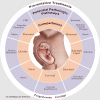Preterm Birth and Corticotrophin-Releasing Hormone as a Placental Clock
- PMID: 36478045
- PMCID: PMC10583728
- DOI: 10.1210/endocr/bqac206
Preterm Birth and Corticotrophin-Releasing Hormone as a Placental Clock
Abstract
Preterm birth worldwide remains a significant cause of neonatal morbidity and mortality, yet the exact mechanisms of preterm parturition remain unclear. Preterm birth is not a single condition, but rather a syndrome with a multifactorial etiology. This multifactorial nature explains why individual predictive measures for preterm birth have had limited sensitivity and specificity. One proposed pathway for preterm birth is via placentally synthesized corticotrophin-releasing hormone (CRH). CRH is a peptide hormone that increases exponentially in pregnancy and has been implicated in preterm birth because of its endocrine, autocrine, and paracrine roles. CRH has actions that increase placental production of estriol and of the transcription factor nuclear factor-κB, that likely play a key role in activating the myometrium. CRH has been proposed as part of a placental clock, with early activation of placental production resulting in preterm birth. This article will review the current understanding of preterm birth, CRH as an initiator of human parturition, and the evidence regarding the use of CRH in the prediction of preterm birth.
Keywords: corticotrophin-releasing hormone; parturition; placental clock; preterm birth.
© The Author(s) 2022. Published by Oxford University Press on behalf of the Endocrine Society. All rights reserved. For permissions, please e-mail: journals.permissions@oup.com.
Figures



Similar articles
-
Corticotrophin releasing hormone and the timing of birth.Front Biosci. 2007 Jan 1;12:912-8. doi: 10.2741/2113. Front Biosci. 2007. PMID: 17127348 Review.
-
Placental corticotrophin-releasing hormone, local effects and fetomaternal endocrinology.Stress. 2001 Dec;4(4):219-33. doi: 10.3109/10253890109014747. Stress. 2001. PMID: 22432143 Review.
-
Associations Between Placental Corticotropin-Releasing Hormone, Maternal Cortisol, and Birth Outcomes, Based on Placental Histopathology.Reprod Sci. 2020 Sep;27(9):1803-1811. doi: 10.1007/s43032-020-00182-x. Epub 2020 Mar 26. Reprod Sci. 2020. PMID: 32219714 Free PMC article.
-
Placental corticotropin-releasing hormone (CRH), spontaneous preterm birth, and fetal growth restriction: a prospective investigation.Am J Obstet Gynecol. 2004 Oct;191(4):1063-9. doi: 10.1016/j.ajog.2004.06.070. Am J Obstet Gynecol. 2004. PMID: 15507922
-
Pregnancy anxiety predicts shorter gestation in Latina and non-Latina white women: The role of placental corticotrophin-releasing hormone.Psychoneuroendocrinology. 2019 Jan;99:166-173. doi: 10.1016/j.psyneuen.2018.09.008. Epub 2018 Sep 9. Psychoneuroendocrinology. 2019. PMID: 30245329 Free PMC article.
Cited by
-
Optimizing Newborn Outcomes in Cesarean Sections: A Comparative Analysis of Stress Indicators under General and Spinal Anesthesia.Children (Basel). 2024 Jun 27;11(7):783. doi: 10.3390/children11070783. Children (Basel). 2024. PMID: 39062232 Free PMC article.
-
Correlation between perinatal abnormalities and decreased fetal movement as counted by a fetal movement acceleration measurement recorder: A prospective cohort study.Int J Gynaecol Obstet. 2025 May;169(2):656-662. doi: 10.1002/ijgo.16101. Epub 2024 Dec 17. Int J Gynaecol Obstet. 2025. PMID: 39688139 Free PMC article.
-
Sex-specific associations between placental corticotropin releasing hormone and problem behaviors in childhood.Psychoneuroendocrinology. 2024 May;163:106994. doi: 10.1016/j.psyneuen.2024.106994. Epub 2024 Feb 16. Psychoneuroendocrinology. 2024. PMID: 38387218 Free PMC article.
-
Associations between maternal plasma concentrations of corticotrophin releasing hormone and the placental transcriptome.Placenta. 2025 Feb;160:29-38. doi: 10.1016/j.placenta.2024.12.021. Epub 2024 Dec 30. Placenta. 2025. PMID: 39755094
-
Upregulated YTHDC1 mediates trophoblastic dysfunction inducing preterm birth in ART conceptions through enhanced RPL37 translation.Cell Mol Life Sci. 2024 Dec 27;82(1):17. doi: 10.1007/s00018-024-05467-x. Cell Mol Life Sci. 2024. PMID: 39725796 Free PMC article.
References
-
- Osterman MJK, Hamilton BE, Martin JA, Driscoll AK, Valenzuela CP. Births: Final Data for 2020. National Center for Health Statistics; 2022. - PubMed
-
- Walani SR. Global burden of preterm birth. Int J Gynaecol Obstet. 2020;150(1):31–33. - PubMed
-
- Vogel JP, Chawanpaiboon S, Moller AB, Watananirun K, Bonet M, Lumbiganon P. The global epidemiology of preterm birth. Best Pract Res Clin Obstet Gynaecol. 2018;52:3–12. - PubMed

